
Early in this century the global community came together in support of eight development goals, to be achieved by 2015. One of those goals addressed educational needs around the world, and called for 100 million more children to be reading by the end of 2015.
This goal shaped the programming of numerous official development agencies, most notably the US Agency for International Development (USAID). For the past decade USAID education programs have focused on improving early grade reading programs around the world, and have had major impacts. In many countries the process of teaching reading has improved significantly. And although exact figures are still being compiled, it is safe to say that today, as a result of USAID program support, at least 70 million children who otherwise would not have had the opportunity have learned to read.
But education is not only about reading, and education does not stop once children learn how to read. Like any skill, reading needs to be practiced. And reading alone is not sufficient to help children develop skills necessary for life. Children must learn to use their reading and other knowledge and skills to find and keep jobs, to enter into healthy relationships with others, to participate fully in the life of their community and society, and to think critically about what they do read.
This past week at the United Nations, the global community came together again to establish a set of sustainable development goals that build on what has already been accomplished. Education-oriented sustainable goals call, among other things, for lifelong learning. In other words, they call for children to continue to learn beyond the early grades or primary school.
The research demonstrates that each additional year of quality schooling has a significant impact on a child’s future prospects. Yet far too many children drop out of school early in their academic career. Tens of millions of children, including many who have gone through a few grades of primary school and who may have learned how to read, drop out. Reasons are varied, including economic need, safety or security, gender discrimination, or simply lack of spaces in middle school.
Children who have dropped out of school are more likely to be unemployed, to join gangs, to engage in criminal behavior, to threaten the security of the country where they live, or to become threats to global security. They are sufficiently literate to join violent extremist organizations and to become threats to global peace.
As donor countries consider ways of incorporating the new sustainable development goals into their development assistance and foreign aid programs, this is a great opportunity to think differently about support to education.
Keeping children in school at least through grade 10 is critical to solidify the effects of education, and to ensure that children have the fundamentals to live a healthy and productive life. To make sure as many children as possible get there, the global community must support children transitioning from primary to middle school by ensuring adequate numbers of schools, classrooms and teachers. We must strengthen the quality of teachers at the middle school level. We must ensure that middle school education is relevant to young people, to help them gain useful, employable skills, and the ability to navigate through life.
If we don’t do that we will surely end up with a generation of disaffected young people who are able to read at a grade school level but who can’t do much else. The new sustainable development goals call us to action now.
Jerrold Keilson is the Vice President and Senior Director of Creative’s Education Division

